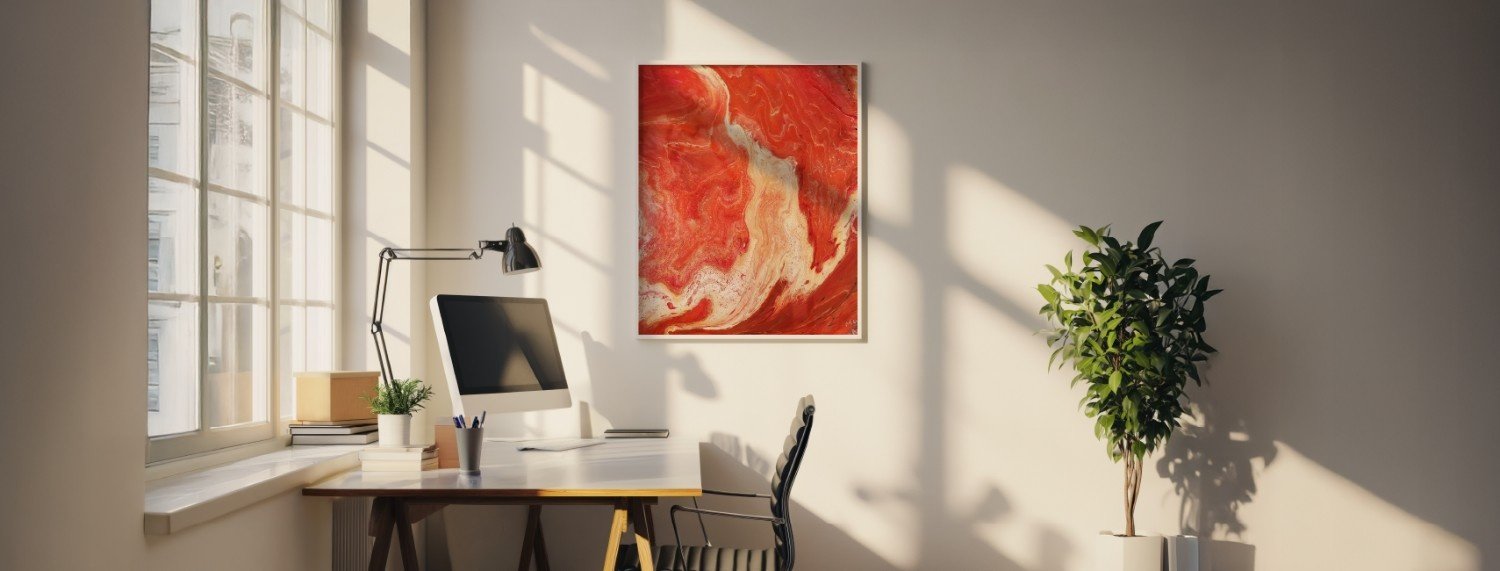You walk into the office. The day begins with a list of tasks, screens light up, and there, hanging on the wall, a solitary clock ticks away. Reliable, functional, and unchanged. It tells time, but it says nothing. No emotion. No character.
In a space where decisions are made, calls are answered, and long hours are spent, the wall behind you should do more than count the minutes. A wall is part of your workspace. It is part of your thinking environment. And yet, many leave it blank or hang a clock and consider the job done.
A modern workplace is expected to support mental clarity, reduce fatigue, and encourage ideas. A bare wall rarely contributes to those goals. Here are ten reasons to reconsider what hangs behind or beside you.
1. A Blank Wall Can Lower the Room’s Energy
Neutrality often seems safe, but in work environments, it can border on dull. Blank walls absorb rather than reflect and they offer no stimulation. In long meetings or late evenings, this absence can reduce cognitive energy. The human brain is a complex machine which benefits greatly from detail. Engaging with visual design can increase attentiveness and reduce fatigue.
2. Art Adds Visual Balance to Functional Spaces
Offices are filled with screens, files, cables, switches, and structured furniture. These objects serve a purpose but rarely offer visual calm. Art and well-designed objects provide a counterbalance. They create points of rest for the eye. They soften the hard edges of technology. A carefully selected piece of modern office wall décor can contribute to a more balanced physical and visual environment.
3. Productivity Improves in Environments that Encourage Focus
Researchers have observed that employees working in visually enriched environments report higher productivity levels. This is not limited to natural light or ergonomic furniture. Wall décor, especially artwork has a measurable effect. A well-curated wall supports concentration by improving overall comfort in the space.
4. A Wall Can Act as a Silent Communicator
In offices where clients or colleagues walk in, what hangs on your wall speaks first. It conveys values, taste, professionalism, and awareness. Whether it’s a minimal photograph or an abstract canvas, it sets a tone. Over time, even you begin to read it differently. Familiar visuals can offer subtle cues, grounding your routine or influencing your state of mind.
5. Mental Health is Affected by the Environment
A well-designed space reduces stress which is no longer debated. Studies link visual aesthetics with reduced cortisol levels and improved emotional regulation. The right artwork or wall element can act as a grounding tool. Even a few minutes of visual pause can slow the mind and recalibrate thought patterns.
Start building that kind of visual support with curated décor pieces that work beyond aesthetics.
6. Decision Fatigue Is Reduced by Curated Visuals
Executives and knowledge workers face thousands of decisions a day. When the environment is neutral to the point of sterile, mental strain accumulates faster. A thoughtfully arranged workspace, including wall décor, allows for small mental shifts throughout the day. It gives the brain subtle places to land. That kind of design detail plays a role in decision-making endurance.
7. A Sense of Completion Matters
In a mundane space which our brain associates with intense work, focus can scatter. When a room looks unfinished, it can feel unsettled. Walls are often the last area to receive attention, and yet they complete the space more effectively than any desk accessory. Modern office wall décor adds the final layer. It shows that someone has considered not just how the room functions but how it feels.
8. Identity is Tied to Environment
You work with your name, your tone, your expertise. Your space should carry that identity. Now, an office wall becomes part of your professional presence. Over time, it shapes how you experience your workday and how others perceive your space.
9. Art Encourages Pausing Without Stopping
In high-performance settings, breaks often feel like lost time. Visual art provides mental rest without needing to leave the desk. The eyes can shift. The thoughts can stretch slightly. This kind of micro-pause prevents burnout and builds mental longevity.
10. A Clock Measures Time. Art Gives It Meaning.
The clock’s function is fixed.
Wall décor, however, adapts with context, grows in meaning, and connects more deeply with experience. A single visual element can reflect your current project, your mindset, or your goals. It becomes part of the way you work, not just a part of the room.
The office is where your mind spends most of its focused hours, so its design should work in your favor.
Find wall décor that meets professional needs with clarity and purpose.

